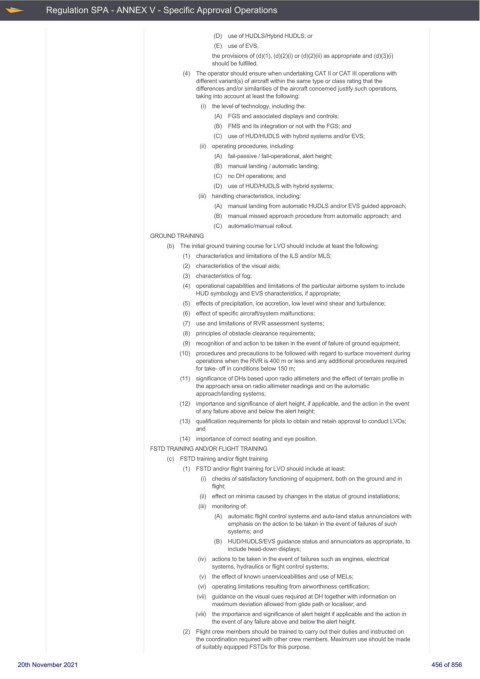Page 456 - UK Air Operations Regulations 201121
P. 456
~
~ Regulation SPA - ANNEX V - Specific Approval Operations Centrik
(D) use of HUDLS/Hybrid HUDLS; or
(E) use of EVS,
the provisions of (d)(1), (d)(2)(i) or (d)(2)(ii) as appropriate and (d)(3)(i)
should be fulfilled.
(4) The operator should ensure when undertaking CAT II or CAT III operations with
different variant(s) of aircraft within the same type or class rating that the
differences and/or similarities of the aircraft concerned justify such operations,
taking into account at least the following:
(i) the level of technology, including the:
(A) FGS and associated displays and controls;
(B) FMS and its integration or not with the FGS; and
(C) use of HUD/HUDLS with hybrid systems and/or EVS;
(ii) operating procedures, including:
(A) fail-passive / fail-operational, alert height;
(B) manual landing / automatic landing;
(C) no DH operations; and
(D) use of HUD/HUDLS with hybrid systems;
(iii) handling characteristics, including:
(A) manual landing from automatic HUDLS and/or EVS guided approach;
(B) manual missed approach procedure from automatic approach; and
(C) automatic/manual rollout.
GROUND TRAINING
(b) The initial ground training course for LVO should include at least the following:
(1) characteristics and limitations of the ILS and/or MLS;
(2) characteristics of the visual aids;
(3) characteristics of fog;
(4) operational capabilities and limitations of the particular airborne system to include
HUD symbology and EVS characteristics, if appropriate;
(5) effects of precipitation, ice accretion, low level wind shear and turbulence;
(6) effect of specific aircraft/system malfunctions;
(7) use and limitations of RVR assessment systems;
(8) principles of obstacle clearance requirements;
(9) recognition of and action to be taken in the event of failure of ground equipment;
(10) procedures and precautions to be followed with regard to surface movement during
operations when the RVR is 400 m or less and any additional procedures required
for take- off in conditions below 150 m;
(11) significance of DHs based upon radio altimeters and the effect of terrain profile in
the approach area on radio altimeter readings and on the automatic
approach/landing systems;
(12) importance and significance of alert height, if applicable, and the action in the event
of any failure above and below the alert height;
(13) qualification requirements for pilots to obtain and retain approval to conduct LVOs;
and
(14) importance of correct seating and eye position.
FSTD TRAINING AND/OR FLIGHT TRAINING
(c) FSTD training and/or flight training
(1) FSTD and/or flight training for LVO should include at least:
(i) checks of satisfactory functioning of equipment, both on the ground and in
flight;
(ii) effect on minima caused by changes in the status of ground installations;
(iii) monitoring of:
(A) automatic flight control systems and auto-land status annunciators with
emphasis on the action to be taken in the event of failures of such
systems; and
(B) HUD/HUDLS/EVS guidance status and annunciators as appropriate, to
include head-down displays;
(iv) actions to be taken in the event of failures such as engines, electrical
systems, hydraulics or flight control systems;
(v) the effect of known unserviceabilities and use of MELs;
(vi) operating limitations resulting from airworthiness certification;
(vii) guidance on the visual cues required at DH together with information on
maximum deviation allowed from glide path or localiser; and
(viii) the importance and significance of alert height if applicable and the action in
the event of any failure above and below the alert height.
(2) Flight crew members should be trained to carry out their duties and instructed on
the coordination required with other crew members. Maximum use should be made
of suitably equipped FSTDs for this purpose.
20th November 2021 456 of 856

